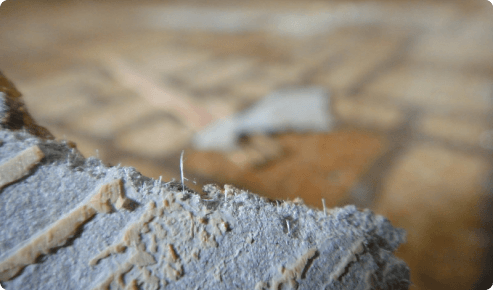

Short-term asbestos exposure involves incidents that last less than a few days. Certain extreme events, such as the toxic exposure caused by the 9/11 attacks, can lead to a high risk of illness later in life. But in general, the health risk from short-term asbestos exposure is low.

The levels of asbestos exposure affect the risk of getting asbestos-related diseases. Every year, these asbestos diseases like mesothelioma kill thousands in the U.S. In 2016, past exposure led to nearly 40,000 deaths, according to the International Commission of Occupational Health.
It’s natural for people to feel concerned after short-term exposure to asbestos. Asbestos has a deadly reputation, but many people don’t know why it’s dangerous.
Short-Term Exposure Fast Facts
Exposure to asbestos happens when someone inhales asbestos dust. Over time, millions of microscopic mineral fibers accumulate in the smooth lining that covers the lungs, abdominal cavity and heart. The buildup leads to scarring, inflammation, and eventually, mesothelioma.
Not everyone exposed to asbestos gets diagnosed with mesothelioma. This is true even for people exposed to large amounts of the mineral. While asbestos is the main cause of mesothelioma, certain risk factors increase the likelihood of developing this cancer.


No amount of asbestos exposure is safe. People must avoid inhaling the toxic dust.
Most asbestos-related diseases arise only after many years of regular exposure. An extremely intense short-term exposure also heightens the risk of disease later in life.
For example, a history of working with insulation products in the 1950s or 1960s is a major risk factor. Even if the work involved only a little exposure at a time. A few months of this would add up to a lot of inhaled asbestos dust.
Most cases of asbestos cancer and asbestosis trace back to this type of occupational asbestos exposure.
Family members were often exposed to asbestos dust brought home by workers on their clothes. This is known as secondhand asbestos exposure. It has been linked to many deaths.
After regulations in the 1970s and 1980s, long-term asbestos exposure became less of an issue in America. However, symptoms of asbestos diseases take decades to show up. For example, symptoms of mesothelioma appear 20 to 60 years after exposure.
In addition, a single event can cause an extreme amount of asbestos exposure. The destruction of the Twin Towers in New York on 9/11 created an enormous cloud of toxic dust. Residents and rescue workers exposed to it have an elevated risk of developing cancer.
Usually, one-time asbestos exposure isn’t a major risk. However, it can be in rare cases with toxic dust. Typically, asbestos diseases arise from long-term exposure at work.
If you were exposed to asbestos for one day, the health risk depends on how much dust you inhaled.
If the answer is yes, and you did not take safety precautions, then you likely inhaled a substantial amount of asbestos dust.
Asbestos exposure will not have any immediate impact on your health. Make sure your doctors are aware of the event, so it is in your medical history. Avoid any further asbestos exposure in the future.
It’s not uncommon for homeowners to find asbestos products after renovations. Thankfully, the risk it poses is low if your house was built after the 1980s. Homes built before that period often contained asbestos.
In many places, trace amounts of asbestos are already in the air. In the countryside, it comes from the erosion of rock formations. In urban areas, it comes from ongoing demolition and construction work.
Light, brief exposure to asbestos usually doesn’t make people sick. One careless renovation won’t increase your risk by much. Still, it’s vital to learn and avoid repeating the mistake.

Access mesothelioma compensation through trust funds, settlements or travel grants.
Get Financial Help NowSeveral risk factors affect the odds of getting sick from asbestos.
Asbestos workers who smoke are at higher risk for lung cancer. However, smoking does not increase the risk of mesothelioma.
Diseases from asbestos exposure often take over 20 years to develop. They start with symptoms that gradually appear and may resemble a cold.
Short-term exposure to asbestos dust can lead to mesothelioma and other forms of cancer. But unless the exposure is intense, the risk of cancer from short-term exposure is low.
To avoid asbestos exposure, it’s important to know which products contained it. If you’re unsure, you should seek professional help to identify the material. If it’s asbestos and poses a danger, a professional should remove it.
Occupational asbestos exposure is still a hazard for many American workers. Demolition workers and firefighters may be exposed to asbestos in old buildings. Mechanics may be exposed to asbestos in vehicle and machine parts imported from overseas.
Recommended ReadingYour web browser is no longer supported by Microsoft. Update your browser for more security, speed and compatibility.
If you are looking for mesothelioma support, please contact our Patient Advocates at (855) 404-4592
The Mesothelioma Center at Asbestos.com has provided patients and their loved ones the most updated and reliable information on mesothelioma and asbestos exposure since 2006.
Our team of Patient Advocates includes a medical doctor, a registered nurse, health services administrators, veterans, VA-accredited Claims Agents, an oncology patient navigator and hospice care expert. Their combined expertise means we help any mesothelioma patient or loved one through every step of their cancer journey.
More than 30 contributors, including mesothelioma doctors, survivors, health care professionals and other experts, have peer-reviewed our website and written unique research-driven articles to ensure you get the highest-quality medical and health information.
My family has only the highest compliment for the assistance and support that we received from The Mesothelioma Center. This is a staff of compassionate and knowledgeable individuals who respect what your family is experiencing and who go the extra mile to make an unfortunate diagnosis less stressful. Information and assistance were provided by The Mesothelioma Center at no cost to our family.LashawnMesothelioma patient’s daughter


King, D. (2025, May 28). Short-Term Asbestos Exposure. Asbestos.com. Retrieved July 15, 2025, from https://www.asbestos.com/exposure/short-term/
King, Daniel. "Short-Term Asbestos Exposure." Asbestos.com, 28 May 2025, https://www.asbestos.com/exposure/short-term/.
King, Daniel. "Short-Term Asbestos Exposure." Asbestos.com. Last modified May 28, 2025. https://www.asbestos.com/exposure/short-term/.
An occupational scientist or another expert who specializes in occupational hazards reviewed the content on this page to ensure it meets current scientific standards and accuracy.
Anna Nowak, Ph.D. is one of the most renowned and celebrated researchers in asbestos science. She is based in Western Australia.
Our fact-checking process begins with a thorough review of all sources to ensure they are high quality. Then we cross-check the facts with original medical or scientific reports published by those sources, or we validate the facts with reputable news organizations, medical and scientific experts and other health experts. Each page includes all sources for full transparency.
Please read our editorial guidelines to learn more about our content creation and review process.
